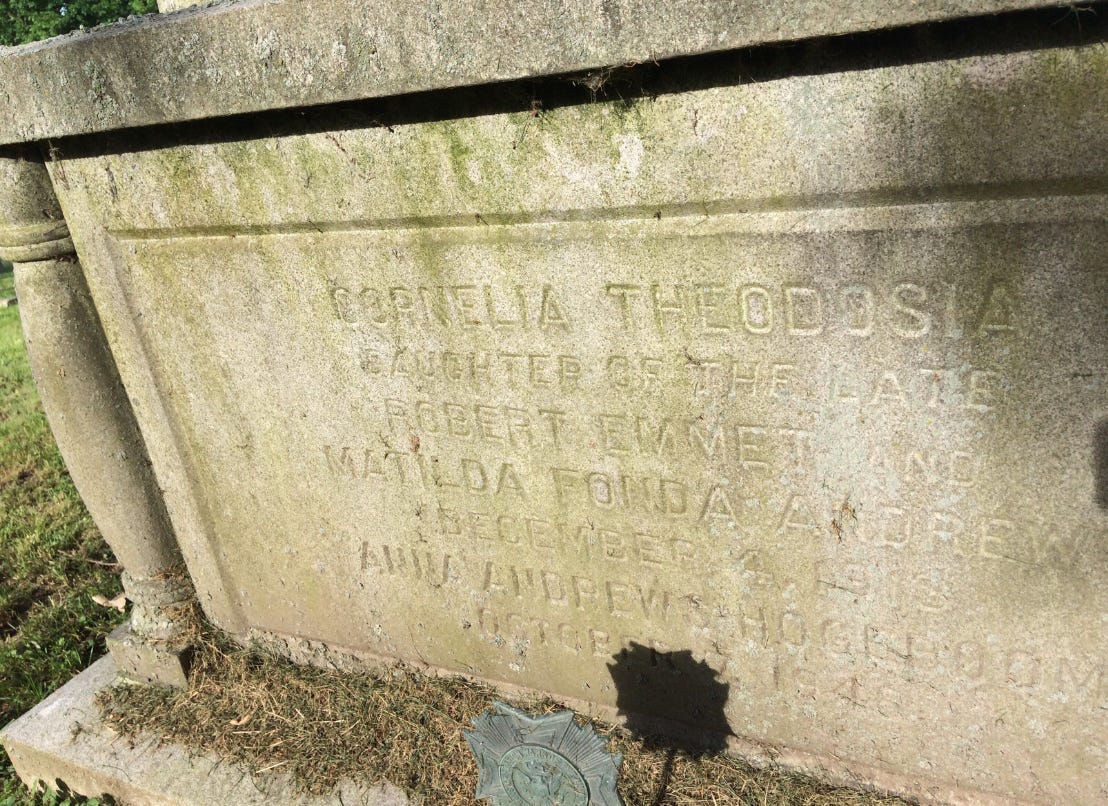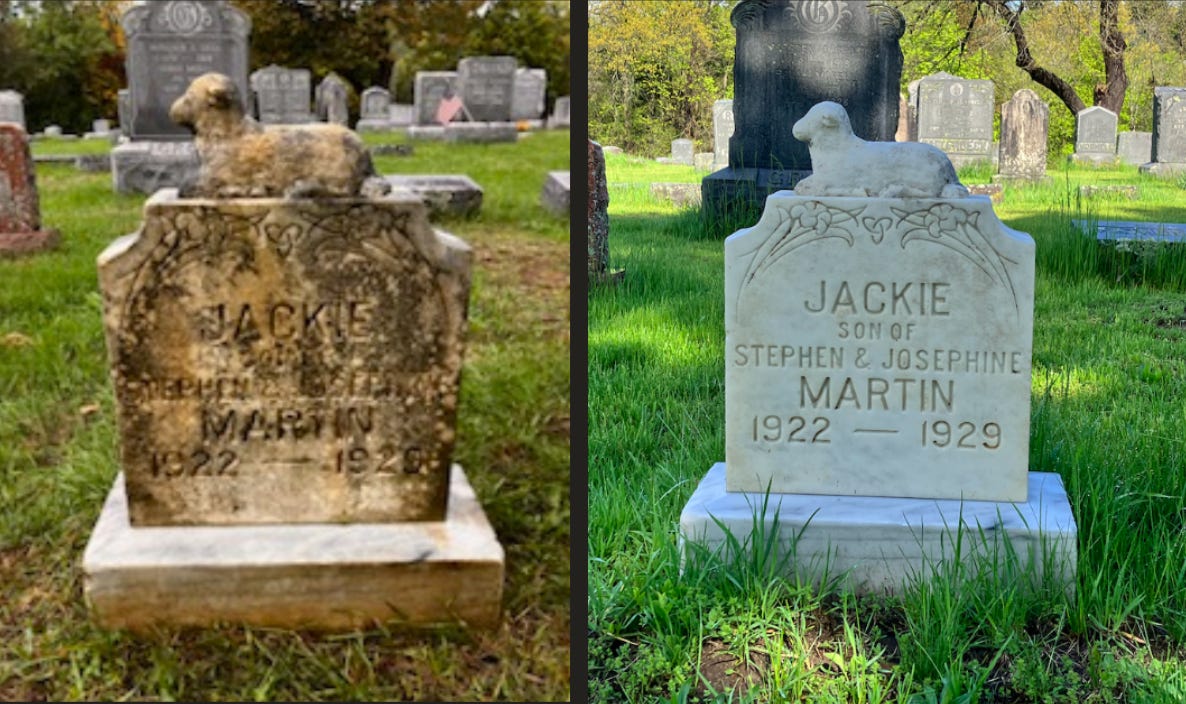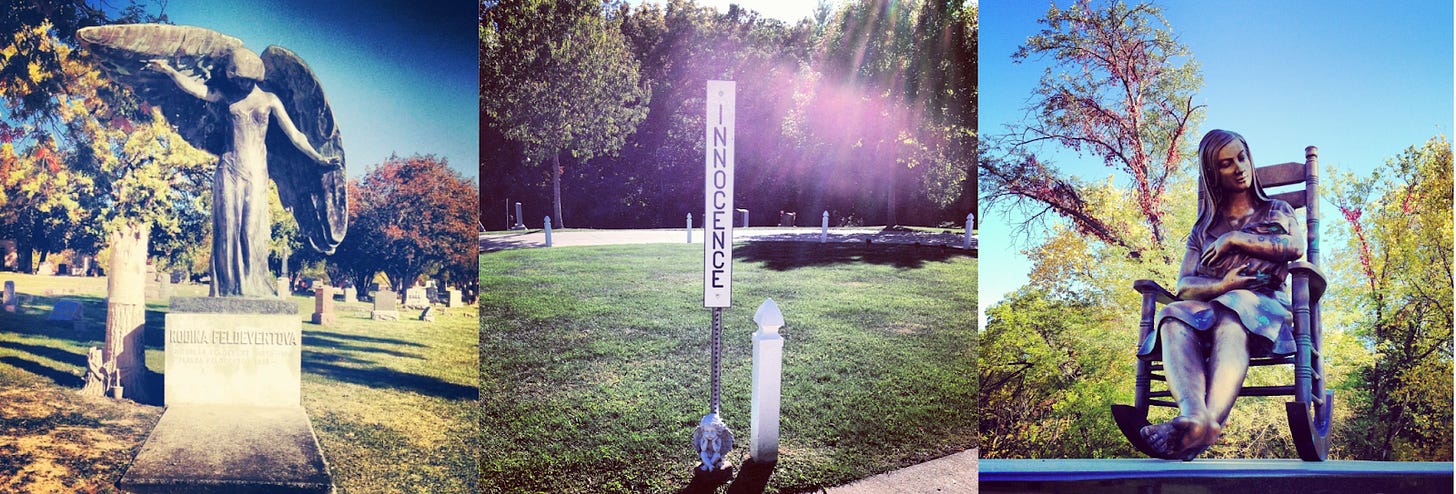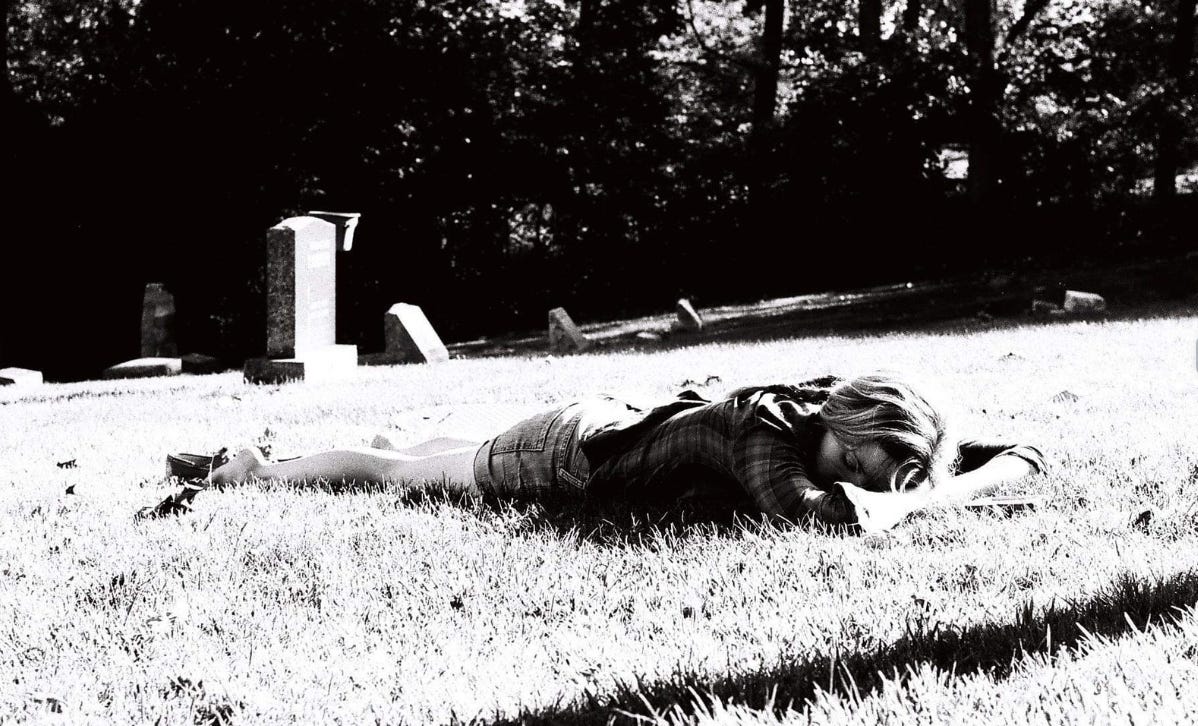A Cemetery Story: Ancestors, Rituals, and a Bike Ride Away
How Cedar Park became my place for grief, memory, and quiet acts of love
For most of my life, I’ve been interested in cemeteries. They’re not usually places people associate with a good time, but for me, they’re spaces of profound connection — to ancestry, to history, to community, and to my own body.
The first cemetery I spent real time in was Hudson’s own Cedar Park Cemetery. Spanning 88 acres of green space and winding roads carved into the side of a hill, Cedar Park was established by the proprietors of Hudson in 1784. Its design was shaped by the national Rural Cemetery Movement — a public health response to the dangers of burying too many people in private lots or crowded churchyards. Originally just five acres, it eventually expanded into the large and beautiful site it is today.

Like Hudson itself, the cemetery is remarkably diverse. There’s a long-established Jewish section dating back to 1888, and in 2019, a Muslim section was added. Civil War and World War II veterans are buried here, many in graves that are lovingly maintained.
And there are prominent locals, too — a few of my favorites:
My favorite grave in Cedar Park is that of George Waring. George Waring ran a clock shop on Warren Street for many years, and he also maintained a gas-powered public clock that kept the rhythm of daily life in Hudson – the City of Hudson paid him $10 per year to maintain it. He designed his own monument prior to his death. It’s a sundial – extremely appropriate given his profession. And it also has the weighty, ominous refrain: The last hour to many, possibly to you.

Cornelia Theodosia Andrews is another favorite of mine. She was a lifelong Hudson resident and a survivor of the Titanic. She and her sister returned to Hudson after the tragedy and lived out their lives in the community they called home. I did a deep dive into her recently and also learned that she attended Oberlin. There are so many Oberlin graduates in Hudson, and I could never really understand why – now I attribute it to Cornelia, who must have opened a portal.

The Folger monuments are also worth noting. Benjamin Folger was one of Hudson’s original proprietors. As a businessman and community leader, he helped establish Cedar Park Cemetery as a dedicated resting place for Hudson’s growing population. His wife, Phoebe Folger, was the very first person buried in Cedar Park.

But none of this is why I started frequenting Cedar Park.
It was, quite simply, one of the first places I was allowed to ride my bike. At eleven, I got permission to cross Fairview Avenue and ride to the cemetery. My parents knew that once I was there, I could ride for hours with my friends and hardly ever encounter a car. We’d meet at a particular stone — who we called “Baby Freddie” — and who I would later come to know and love the family of (that’s a story for another post). At that age, Cedar Park represented joy and independence.

As I grew older, I learned to revere Cedar Park not just for its winding bike paths but for the generations of my family buried within it. I have dozens of ancestors there. My oldest Hudson ancestor, Giacobbe Matteo — later known as Jacob Martin — was born in 1857 and buried in Cedar Park in 1920. He and his wife, Johanna Mastrangelo (later Jennie Martin), had eleven children in Hudson, nearly all of whom are buried there with their spouses.

Growing up playing in the cemetery meant I was always among my people, whether I realized it or not. My mom and grandmother would sometimes take me for picnics by the stones of our ancestors — especially Jennie and Jacob, my Grandma Pat Westermann’s grandparents. As a kid, I was drawn to the stone of Jackie Martin, a cousin of my grandma’s who died as a child and whose grave features a lamb. My mom told me she loved that grave as a child, too. Now, as an adult, the loss of a child feels nearly incomprehensible. But I like to think that children are playing at Jackie’s memorial, eating lunch nearby, exactly one hundred years after his death. It brings a kind of relief — a sign that he hasn’t been forgotten.

At eighteen, I left Hudson for college. I spent time in other cities and fell in love with other cemeteries: Mount Hope Cemetery in Rochester, where I did my undergrad, and Oakland Cemetery in Iowa City, where I earned my PhD. But even when I lived far away, I returned to Hudson at least once a year, always making time to visit Cedar Park and do the rounds to visit my people.

When I moved back to Hudson in 2018, I started a genealogy project to learn more about my ancestors. I turned to their gravestones for names and dates — but many were too covered in lichen and grime to read. So I researched proper cleaning techniques and began gently, carefully, cleaning each of my ancestors’ stones.
What started as a quest for information became something more. I really liked cleaning gravestones. It felt like a way to honor the person — to give them something with my body that I may never have had the chance to offer in life. It became a regular practice, one I’ve even shared with my children, that keeps me connected to those who came before me.
Over time, gravestone cleaning evolved into a somatic practice — something physical and grounding that allows me to stay present in an overwhelming world. All over the world, horrible things are happening: people are being killed, children suffering — many I will never meet or know. I often feel powerless. It’s tempting to check out, to become numb or cynical. But cleaning gravestones keeps me tender. It brings me back to my humanity. It reminds me how precious each life is — even the ones long gone, even the ones I’ll never know.
My stepdad, Don Dolan, died two and a half years ago. He’s buried at Cedar Park, and I visit him several times per week. Sometimes I sit quietly. Sometimes I talk to him. Sometimes I play Van Morrison and smoke a joint. His presence there has deepened my relationship to the cemetery — it’s not just a space of memory now, but one of daily companionship and care.

I’ve also leaned into feeling my other ancestors more vividly. I sometimes rest my back against their stones, feeling for their strength and steadiness. In hard moments, I call on them – not just in thought, but through my body. I imagine what it took for them to survive, to parent, to grieve, to keep going. I feel them at my back when I need courage. I draw from their resilience when I feel unsure.
I especially think of Jennie Martin. A mother of eleven, widowed at 42, never to remarry. She figured out how to make ends meet in Hudson, running her own store at 2 Warren Street. I imagine her grit, her wisdom, her struggle, and her fierce love for the descendants she’d never meet — including me. I send her my love. And I feel hers in return, especially when I need it most.
If you’re interested in learning how to clean gravestones yourself, I’d love to share what I’ve learned. You can check out this presentation I gave in the fall, which walks through the tools, techniques, and care needed to do it respectfully and safely. Whether you’re tending to your own ancestors or a stranger’s stone that speaks to you, the act of cleaning is a small but powerful way to offer reverence.
For me, this practice started with curiosity, deepened into a ritual, and has become a quiet form of love. The cemetery isn’t just where my people are buried. It’s where I remember, listen, move, cry, connect, and sometimes just breathe. It’s a place where the past and present touch — and where, somehow, I always feel life.





I so enjoyed learning about Cedar Park through you and your experiences. My husband, dog and I are planning to move up to Hudson from Westchester before long. One of my favorite pastimes down here has been to spend lots of time in Sleepy Hollow cemetery. On each of my visits i pick one or two random names, go home and research them and their lives. Ive learned about so many fascinating if obscure people. I will miss them all when we finally move, but now i know i can continue on with the same interest in Cedar Park. Thank you for the inspiration, Sue Fox
I love cemeteries too, especially the one in Truro, MA where I grew up and recently bought a family plot, and I appreciate catching your feeling for Cedar Park.